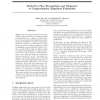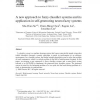1262 search results - page 24 / 253 » Diagnosis Problem Solving Using Fuzzy Relations |
KR
1992
Springer
14 years 3 months ago
1992
Springer
While it has been realized for quite some time within AI that abduction is a general model of explanation for a variety of tasks, there have been no empirical investigations into ...
TFS
2008
13 years 10 months ago
2008
Abstract--This study proposes an efficient self-evolving evolutionary learning algorithm (SEELA) for neurofuzzy inference systems (NFISs). The major feature of the proposed SEELA i...
RSCTC
2000
Springer
14 years 2 months ago
2000
Springer
We discuss how Case Based Reasoning (CBR) (see e.g. [1], [4]) philosophy of adaptation of some known situations to new similar ones can be realized in rough set framework [5] for c...
SIGIR
2005
ACM
14 years 4 months ago
2005
ACM
State-of-the-art question answering (QA) systems employ termdensity ranking to retrieve answer passages. Such methods often retrieve incorrect passages as relationships among ques...
IJON
2006
13 years 11 months ago
2006
A classifier system is a machine learning system that learns syntactically simple string rules (called classifiers) through a genetic algorithm to guide its performance in an arbi...


